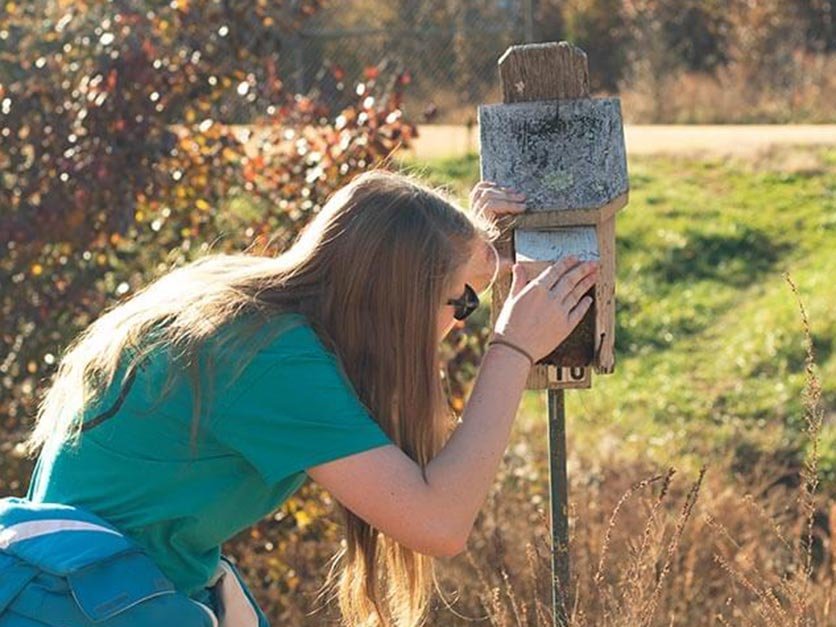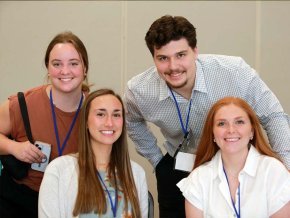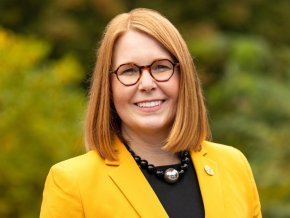Campus nature preserve offers field opportunities

The preserve is a 40-acre swathe of land with a variety of habitats that has allowed LR students and staff to do a variety of field research for decades.
Lenoir-Rhyne University junior Samantha Jarrett loves working her way through a winding creek bed in search of rare species, and climbing uphill through a briar patch to check on bluebird nesting boxes just brings a smile to her face.
She has easy access to do both thanks to the Tally O. and Marjorie B. Bowman Nature Preserve and Outdoor Classroom on LR's campus in Hickory.
"I've always loved going out in the woods as a small child, but I didn't think I could make a living doing that," Jarrett said. "Then the second semester of sophomore year, I saw there was a field biology class and it sounded interesting. It's the best class I have ever taken and completely rerouted the trajectory of my life."
Formerly a biology major with an eye towards veterinary medicine and pursuing ecological interests in her free time, now Jarrett has plunged head first into pursuing a career of biological study and ecological preservation thanks to her experience taking theoretical knowledge and applying it to the nature preserve just a stone's throw away from the Minges Science Building.
"We are very, very fortunate because a lot of institutions can't really do any field work without going away," said Marsha Fanning, Ph.D., professor of biology and chair of the School of Natural Sciences at LR. "One of the issues we have here is [student] transportation. So it's really helpful for us to be able to do research right here in our backyard."
Before it was LR's backyard, it was a backyard of the Mauser family. A land-swap deal in 1969 gave a piece of farmland to the Mausers, which they still use today, in exchange for a 40-acre swathe of land with a variety of habitats that has allowed LR students and staff to do a variety of field research for decades.
The preserve features changes in elevation, open fields and hardwood trees, a creek bed, and scores of plants both native and invasive, as well as an eclectic mix of wildlife.
"We have photos of racoons, opossums, groundhogs," Fanning said. "We have red and gray foxes, red-tailed hawks, and we have a bluebird trail with boxes for nesting bluebirds. There are salamanders by the creek, and we just found a black snake."
Fanning said a variety of classes have utilized the area over the years with ecology, field biology, and other natural sciences courses benefitting directly from field research.
Despite being in the middle of a city, the preserve still affords students the opportunity to tailor their academic interests in the field of natural sciences. The presence of kudzu has given classes the chance to study, up close, the effects of invasive plant species, however, they're also able to study the rare dwarf-flowered heartleaf (Hexastylis naniflora), a threatened species of flowering-plant limited to a small area in the Piedmont of North and South Carolina.
The ecology lab each year does a species diversity study on insects with students cataloging insect species on the preserve compared to those on the neighboring practice soccer field.
"The soccer field is highly controlled with herbicides and pesticides, so there might be gnats and flies," Fanning said. "In the preserve, there are scores of different insects of all sizes, shapes, and colors. We do a lab where the students write up a research project on it."
"You're still in class technically," Jarrett said. "But you're applying the things that you learned in the classroom outside. When you're out there and identifying birds, that's something that can be really important for certain research projects and field biology.
"Because of what I learned here, I was given the opportunity in May to do other field research (with John Brzorad, Ph.D., associate professor of biology) at the Tom Yawkey Wildlife Center in South Carolina for two weeks. We studied the foraging behaviors of small egrets and herons, and we were doing a survey of what birds were out there."
For the next generation of ecologists and scientists looking at preserving the natural landscape, the Tally O. and Marjorie B. Bowman Nature Preserve and Outdoor Classroom is a place where they can get their start.
"Having remote cameras [in the preserve] really opened my eyes to just how much it's used [by wildlife] and how exciting it is that we have so much wildlife right here on campus," Fanning said.

Lenoir-Rhyne University students showcased their academic excellence and research expertise at the 2025 North Carolina Academy of Science (NCAS) annual meeting in late March.
View More
Lenoir-Rhyne University has selected Summer McGee, Ph.D, as the institution’s 13th president. Her appointment was enthusiastically approved by the Lenoir-Rhyne Board of Trustees after a national search.
View More